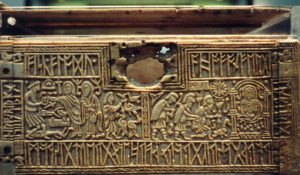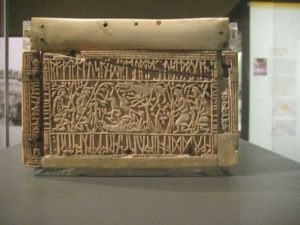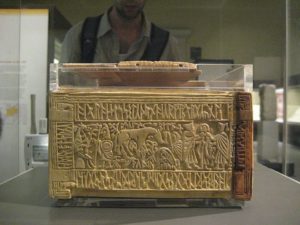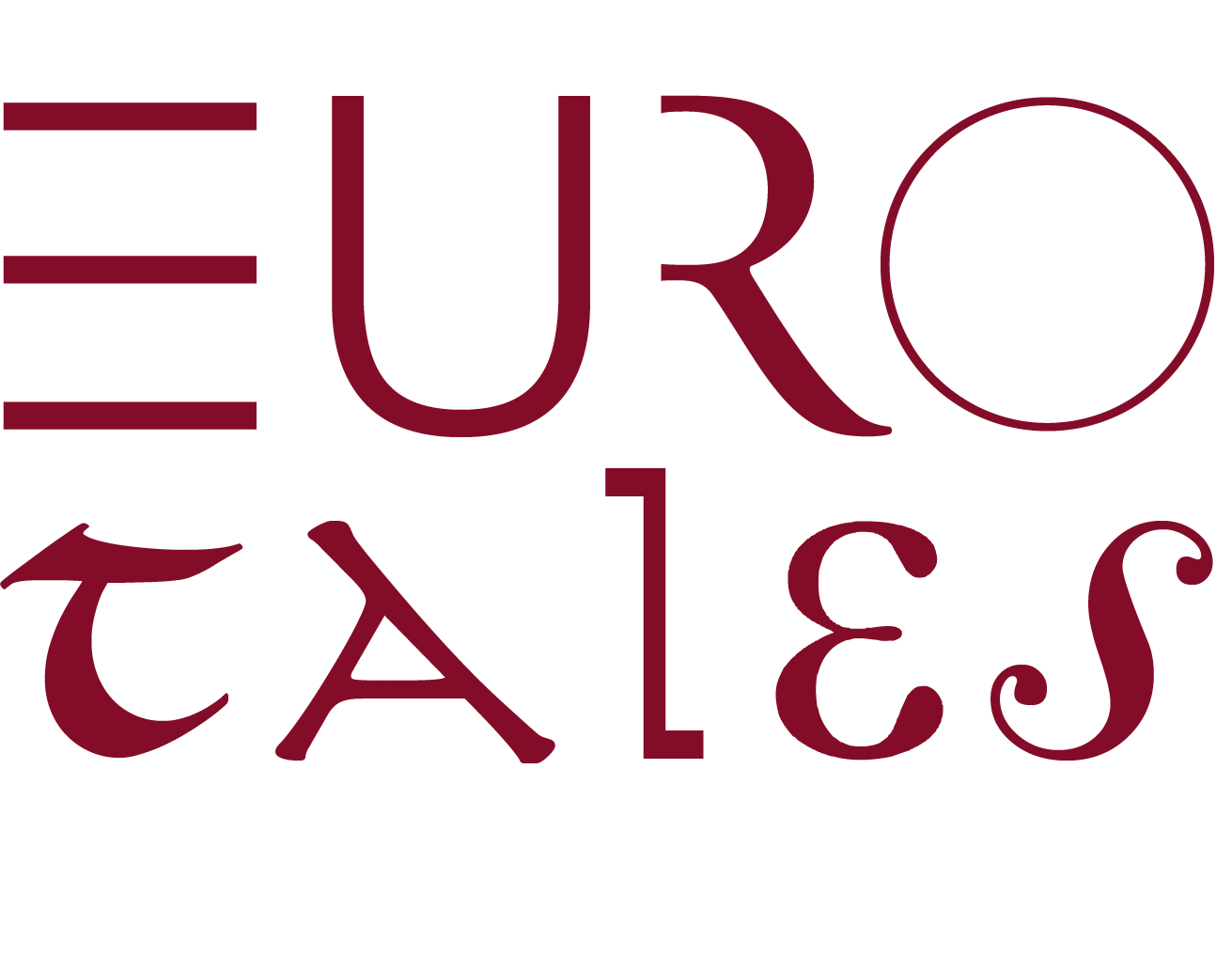Inscriptions
Front Panel: ᚠᛁᛋᚳ.ᚠᛚᚩᛞᚢ.ᚪᚻᚩᚠᚩᚾᚠᛖᚱᚷ | ᛖᚾᛒᛖᚱᛁᚷ | ᚹᚪᚱᚦᚷᚪ:ᛋᚱᛁᚳᚷᚱᚩᚱᚾᚦᚫᚱᚻᛖᚩᚾᚷᚱᛖᚢᛏᚷᛁᛋᚹᚩᛗ | ᚻᚱᚩᚾᚫᛋᛒᚪᚾ [fisc.flodu.ahofonferg | enberig | warþga:sricgrornþærheongreutgiswom | hronæsban] Front panel caption above figures: ᛗᚫᚷᛁ [mægi] Left Panel: ᚱᚩᛗᚹᚪᛚᚢᛋᚪᚾᛞᚱᛖᚢᛗᚹᚪᛚᚢᛋᛏᚹᛟᚷᛖᚾ | ᚷᛁᛒᚱᚩᚦᚫᚱ | ᚪᚠᛟᛞᛞᚫᚻᛁᚫᚹᚣᛚᛁᚠᛁᚾᚱᚩᛗᚫᚳᚫᛋᛏᚱᛁ: | ᚩᚦlᚫᚢᚾᚾᛖᚷ [romwalusandreumwalustwœgen | gibroþær | afœddæhiæwylifinromæcæstri: | oþlæunneg] Back panel, upper left quadrant: 'ᚻᛖᚱᚠᛖᚷᛏᚪᚦ | +ᛏᛁᛏᚢᛋᛖᚾᛞᚷᛁᚢᚦᛖᚪᛋᚢ' [herfegtaþ | +titusendgiuþeasu] Back panel, upper right quadrant: ( Latin, partly in Latin letters and partly in runes) HICFUGIANTHIERUSALIM | ᚪᚠᛁᛏᚪᛏᚩᚱᛖᛋ' [hicfugiantHierusalim afitatores] Back panel, bottom left corner: ᛞᚩᛗ [dom] Back Panel, bottom right corner: ᚷᛁᛋᛚ [gisl] Right panel Transliteration (with cryptic symbols indicated by *) : [h*rh*ss*t*þ*nh*tmb*rg**gl / dr*g*þsw* / h*r**rt**g*sgr* / nds*fat*rn*] [Her hos sittaþ on harmberg a ægl[æ(ca] / drigiþ swah / iri ertæ egi sgræf sar den sorga / ænd sefa torna] Three words within the central picture: [risci] , [wudu], [bita] Lid: ᚫᚷᛁᛚᛁ [ægili]
Front panel: ‘The fish arose by means of the floods/high tide Onto the world/life-mountain’ (=cliff) or 'The flood/high tide raised/lifted up the fish onto the world/life-mountain’ (= cliff) Front panel caption above figures: [the] Magi Left panel: Romulus and Remus (were) two (twin) brothers - a she-wolf raised them - in the city of Rome far from the native land Back panel, upper left quadrant: Here Titus and a Jew fight Back panel, upper right quadrant: Here the/its inhabitants [classical Latin habitatores] flee from Jerusalem Back panel, bottom left corner: judgement Back Panel, bottom right corner: captive Right panel, around the edges: Here/listen, the company preside/s [3rd pers.sg.pres. or 3rd pers.pl.pres.] over the harmful / burial place/mound [acc.] (always). The awesome opponent/ferocious fighter always performs/acts/endures. Anger has left. Ertæ assigned/decreed by means of the horse: distress, the grave of sorrows, and the sad mood'. Three words within the central picture: rush wood biter Lid: Ægili (masculine personal name)
Description
[caption id="attachment_9821" align="alignnone" width="300"] Franks Casket Front Panel[/caption]
[caption id="attachment_9822" align="alignnone" width="300"]
Franks Casket Front Panel[/caption]
[caption id="attachment_9822" align="alignnone" width="300"] FC Back panel[/caption]
[caption id="attachment_9823" align="alignnone" width="300"]
FC Back panel[/caption]
[caption id="attachment_9823" align="alignnone" width="300"] Franks Casket Left Panel[/caption]
[caption id="attachment_9824" align="alignnone" width="300"]
Franks Casket Left Panel[/caption]
[caption id="attachment_9824" align="alignnone" width="300"] Franks Casket Right Panel[/caption]
No one knows the history of this whale-bone box. Dialectal features of its Old English inscriptions identify it as 8th Northumbrian, as does its style of decoration (that resembles 8thc Northumbrian manuscript art), and its unusual mixtures of inscriptions and carvings. This object is covered in carved images and inscriptions, including both Old English and Latin inscriptions in runic writing, and one Latin alphabet inscription. Likewise, the carved scenes present stories and legends of mixed origins: Roman (Romulus and Remus), Jewish (Capture of Jerusalem by Titus), Biblical (the Adoration of the Magi) and Germanic (Weland the Smith, Egil, and one unidentified story). The “densely crammed narrative of text and image” is unique and attests to a sophisticated grasp of cultural and iconographic parallels and interplay, thus indicating links with a major centre of learning (perhaps Lindisfarne, or Monkwearmouth/Jarrow). The casket shares the following distinguishing features with the Ruthwell monument: the presence on the same object of both futhorc and Latin alphabet insriptions, the use of runic writing for Latin as well as Old English, and indications of the Northumbrian dialect.
Franks Casket Right Panel[/caption]
No one knows the history of this whale-bone box. Dialectal features of its Old English inscriptions identify it as 8th Northumbrian, as does its style of decoration (that resembles 8thc Northumbrian manuscript art), and its unusual mixtures of inscriptions and carvings. This object is covered in carved images and inscriptions, including both Old English and Latin inscriptions in runic writing, and one Latin alphabet inscription. Likewise, the carved scenes present stories and legends of mixed origins: Roman (Romulus and Remus), Jewish (Capture of Jerusalem by Titus), Biblical (the Adoration of the Magi) and Germanic (Weland the Smith, Egil, and one unidentified story). The “densely crammed narrative of text and image” is unique and attests to a sophisticated grasp of cultural and iconographic parallels and interplay, thus indicating links with a major centre of learning (perhaps Lindisfarne, or Monkwearmouth/Jarrow). The casket shares the following distinguishing features with the Ruthwell monument: the presence on the same object of both futhorc and Latin alphabet insriptions, the use of runic writing for Latin as well as Old English, and indications of the Northumbrian dialect.
This casket was found and dismantled in Auzon, France in the 19thc, and Augustus Franks subsequently found and bought most of the panels (in Paris in 1857), presenting them to the British Museum, where the box was reassembled (including a replica of most of the right panel, that had ended up in Italy). One panel from the lid is missing, and most of the right panel is the Museo Nazionale del Bargello in Florence (Carrand Collection no. 25). The five surviving decorated panels are variously accompanied by carved texts in Old English and Latin, using both conventional and encoded runes as well as Latin alphabet (insular script), in a variety of orientations. Each side is bordered by a long descriptive text and three contain additional labels; the lid panel has only the latter, though a longer text may originally have accompanied it. The lid depicts an archer, labelled Ægili, perhaps the Germanic hero Egil and brother of Weyland (these are disputed), single-handedly defending a fortress against a troop of attackers, who may be giants. The front: the left half shows a composite scene from the Weland the Smith legend, the right half, the Adoration of the Magi, with the label mægi carved in runes above the kings. The main inscription takes the form of a riddling alliterative verse (see inscriptions section). The form flodu (flood, sea etc) is either an exceptionally old usage (where the –u should have been lost at the beginning of the 7th century) or one of the words that has been abbreviated for lack of space, in which case it could stand for flodum (a dative plural form); alternatively it could be an abbreviation of a following word ‘up’. The inscription on this side contains a one word whose meaning is not clear fergenberig, and that has been interpreted as a compound word meaning ‘life’ or ‘world’ + ‘mountain’. The function of the dots after fish and flodu is also not entirely understood. The left end panel depicts Romulus and Remus nurtured by the wolf with an inscription describing the scene. The back panel shows the capture of Jerusalem in AD 70 by the Roman general, later emperor, Titus: labels on the two lower corners read 'dom' = 'judgment', and 'gisl' = 'hostage' respectively. The main inscription is in a mixture of Old English, Latin, runes and insular script. The right end panel poses special problems of interpretation. The apparently episodic scene is evidently from Germanic legend but has not been satisfactorily identified. Three labels read: 'risci' = 'rush', 'wudu' = 'wood' and 'bita' = 'biter'. The main runic text is in alliterative verse partly encoded by substituting cryptic forms for most of its vowels and perhaps certain other letters.
Storage
The carvings are in good condition, but the box was dis-assembled and partly damaged in the 19thc. The right panel is constituted of some original parts and (mostly) a replica of the original [in the Bargello Museum, Florence]. More than half of the lid is missing. There is some damage where the original silver fittings used to be. Some internal repairs.
Bibliography
British Museum Collections Database, The Franks Casket., «https://www.britishmuseum.org/collection/object/H_1867-0120-1», London, British Museum, 2021
Gaby Waxenberger, "The Inscriptions on the Franks Casket", «eds. G Waxenberger & K. Kazzazi & J. Hines, Old English Runes: Interdisciplinary Perspectives on Approaches and Methodologies», Berlin, de Gruyter, 2022
Gaby Waxenberger, "The Date and Provenance of the Auzon/Franks Casket Revisited: a Linguistic and Runological Perspective", «eds. G Waxenberger & K. Kazzazi & J. Hines, Old English Runes: Interdisciplinary Perspectives on Approaches and Methodologies», Berlin, de Gruyter, 2022
L. E. Webster, “Stylistic aspects of the Franks Casket, «in R.T. Farrell (ed.), The Vikings», Bognor Regis, Phillimore, 1982, 20-31
R. I. Page, An Introduction to English Runes, Woodbridge, The Boydell Press, 1999
Links
Transcription author: Gaby Waxenberger
Card author: Margaret J-M Sonmez
Translation author: Gaby Waxenberger
Franks Casket
Trace type: signing up
Material: Skeletal whale bone
Dimensions: 22.9 cm long, 19 cm wide, 10.9 cm high
Dating: 700-250
Year: 8th c.
Language: Old English, Latin
Writing systems: Runic writing,Latin alphabet
Produced in Northumbria, perhaps in the Monastery of Monkwearmouth-Jarrow.

